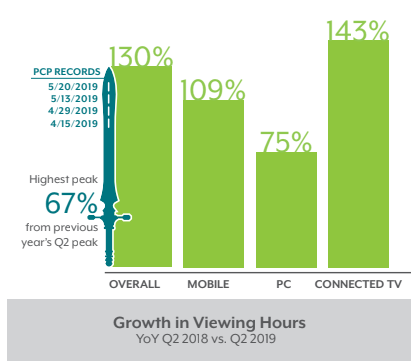FOSTER CITY, Calif.—The number of hours viewing streamed content among U.S. consumers increased 130% overall over the past 12 months, with connected TV seeing the biggest jump at 143% according to Conviva’s “State of the Streaming TV Industry” report.
Streaming over mobile devices increased a healthy 109% over the same period with streaming over PCs increasing 75%. This translates to 28.8 minutes of watch time per play for connected TVs, 12 for mobile and 15.1 minutes per play for PCs.

Peak times for streaming real-time content broke records four times in Q2 2019, all coinciding with the final season of HBO’s “Game of Thrones;” first on April 15, when it streamed in Asia, April 29, when it streamed in the U.K., and May 13 and May 20, when the final two episodes were streamed in the U.S. These beat the previous record by 67%, set in 2018 during the FIFA World Cup.
The top 15 U.S. markets all experienced triple digit growth in viewing hours with Dallas, Atlanta and Phoenix the top three markets. Minneapolis/St. Paul saw the largest growth of hours streamed at 170%.
Tech issues such as buffering and start failures and delays pose a significant hazard for streaming ads, according to Conviva, which noted that 47% of expected ad opportunities went unfilled because of technical problems over the past 12 months.
“Failures are amplified and particularly impactful considering the multiplier effect across subsequent ad breaks if a viewer tunes out due to a poor ad experience,” Conviva said. “In 2019, with new platforms vying for consumer dollars, focus on the entirety of the viewing experience will be an important factor in continued retention and monetization of viewers.”
As streamers gain more and more information about viewers, the quality of the ads will become more important, Conviva said, which also recommended fewer commercial breaks to avoid viewer fatigue. The researcher also advised streamers to experiment with shortening the 30-second ad so characteristic of traditional TV breaks.
The professional video industry's #1 source for news, trends and product and tech information. Sign up below.
“With less time and fewer ad breaks to convert a viewer into a purchaser, the quality of each ad is paramount to carry out the promise of streaming to match the perfect ad to the perfect viewer,” Conviva said.
With more connected TVs integrating streaming services into the sets themselves, this gave Roku the advantage as it notched a 43% market share among streaming services, a 173% year-over-year growth, according to Conviva. Amazon Fire TV was next with 18% share among connected TV devices. Apple TV was up 129% to account for 10% share. Xbox, with a 9% share, led the way in improved buffering while Apple TV received the highest marks in performance, including best video start time and picture quality.
Tom has covered the broadcast technology market for the past 25 years, including three years handling member communications for the National Association of Broadcasters followed by a year as editor of Video Technology News and DTV Business executive newsletters for Phillips Publishing. In 1999 he launched digitalbroadcasting.com for internet B2B portal Verticalnet. He is also a charter member of the CTA's Academy of Digital TV Pioneers. Since 2001, he has been editor-in-chief of TV Tech (www.tvtech.com), the leading source of news and information on broadcast and related media technology and is a frequent contributor and moderator to the brand’s Tech Leadership events.

